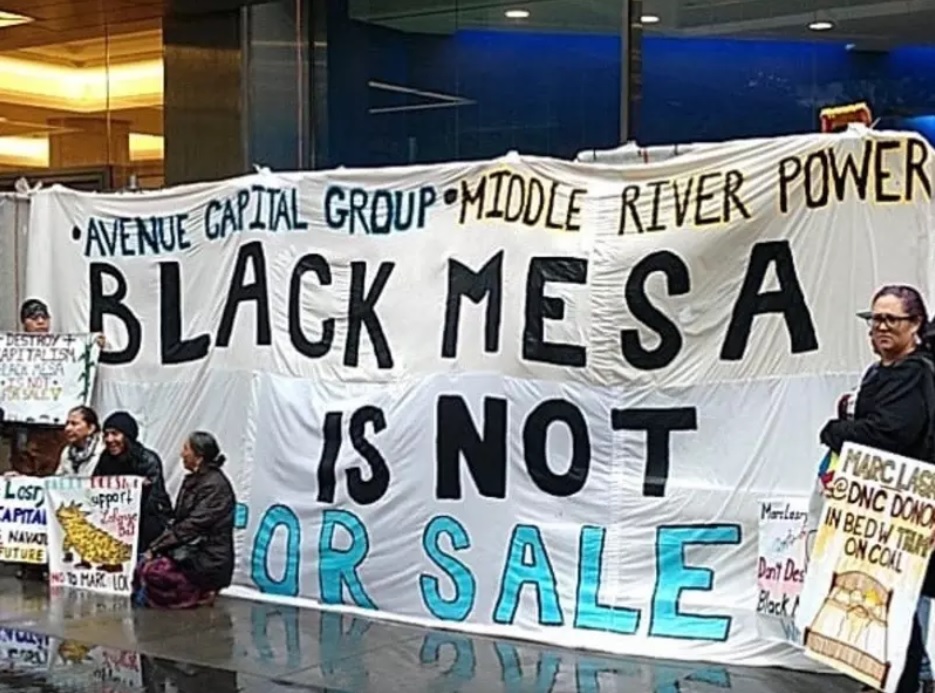Protesters arrived outside the offices of a private equity firm run by a billionaire closely tied to the Clinton family on Monday, urging the company to abandon plans to keep a 44 year-old coal fired power plant on tribal lands running five years past its scheduled shut-down.
Members of the Navajo nation traveled from Arizona to Avenue Capital Group’s offices in New York City to push for a 2019 closure of the Navajo Generating Station (NGS), near Page, Arizona. Instead, they called for the construction of renewable energy projects, which they say could provide less expensive electricity while putting people to work and bringing power to tens of thousands on the Navajo Nation reservation.
For years, the Navajo Generating Station (NGS) and its associated coal mine has been a source of high-paying jobs for some locals and revenue for the Navajo and Hopi governments. It’s also “one of the biggest polluters in the West,” according to High Country News, which estimates that every year the power plant and mine spew 20 million tons of greenhouse gases, both carbon dioxide and methane, and over 472 million pounds of toxic mercury, selenium and arsenic into the air.
It’s the economic implications of Avenue Capital’s plans to run the plant at a reduced capacity, as well as the environmental and public health concerns, that brought the protesters to New York.
“I am the new generation from Black Mesa,” said Rene Simonson, a 19-year old student from Big Mountain, Arizona, “and our challenge is to continue fighting for our existence.”
Roughly half a million Americans work in the wind, solar and related industries, according to a 2017 Department of Energy report.
“The entire world is moving toward renewable energy and the Navajo Nation will be left out,” Simonson added. “My vision is to see my Navajo people have economic opportunities that do not destroy our culture and language.”
Some of those protesting had direct experience with the coal industry’s jobs and its economic promises – and they came prepared to talk about the lessons they had learned.
“I have multiple family members who work at Peabody Energy’s Kayenta Mine as well as in other extractive industries, including oil, gas and copper,” said Nicholas Ashley, 24 year-old coordinator with Tó Nizhóní Ání Clean Energy for a Healthy Arizona. “I have family members who have died and others have been injured from on-site accidents because it is dangerous.”
Nicholas Ashley and his daughter, Photo credit: Tó Nizhóní Ání via wakalet.com
Since it was first built in 1969, the NGS has provided electricity to cities including Pheonix, Las Vegas and Los Angeles – but on the roughly 27,000 square miles of Navajo Nation land surrounding the plant, roughly a third of homes still lack electricity.
“To me Peabody Coal provided a few high paying jobs, and encouraged the Navajo Tribe not to invest in other alternative forms of energy, and by doing so prevented other Navajos from creating jobs in alternative energy and promoted unemployment in the communities,” said John H. Yazzie Jr., 54, a former forestry technician who lives in Flagstaff, AZ. “To me the corporation has increased the economic gap between the rich and poor, and further undermined the community as a support mechanism for the individual.”
Trump Digs Coal – And So Does One of Hillary’s Biggest Donors
Peabody Coal was supposed to be on its way out after local utilities decided in February 2017 that the aging plant and its coal mine were too expensive to keep running. But the Trump administration’s Department of the Interior, under Sec. Ryan Zinke, has fought to keep the plant open, an E&E News investigation found last month.
Interior Department emails first reported by E&E News show Peabody pushed the Interior Department to work with the Pruitt’s Environmental Protection Agency to clarify Clean Air Act “regulatory relief” for the plant, to vouch for “opportunities to operate NGS more efficiently from an engineering perspective” and to “encourage” the plant’s largest customer to buy coal-fired power instead of renewable energy – a list that an official from the Office of the Secretary of the Interior described as “reasonable requests that don’t put us at risk.”
This past April, Avenue Capital Group and Middle River Power were first publicly identified as potential buyers of the 2,250 megawatt Navajo Generating Station and an associated Peabody Energy coal mine in emails obtained by Bloomberg.
But Avenue Capital’s political ties may prove to be a liability for the private firm if the NGS deal depends on more favors from the Trump administration.
Avenue Capital Group is run by Marc Lasry, who was one of Hillary Clinton’s biggest fundraisers. Chelsea Clinton worked for Lasry’s hedge fund from 2006 to 2009, and the Clintons recently attended Lasry’s wedding in August.
Outside Avenue Capital’s offices. Photo credit: Tó Nizhóní Ání via wakalet.com
Big Mountain, Black Mesa
While NGS apparently counts supporters in the powerful orbits of both Trump and Clinton in Washington D.C., in the rural communities where the decision will have its greatest impacts, many objections to keeping the coal power plant running remain.
That skepticism is fueled in part by long-running experience with both colonialism and energy extraction, protesters said.
“My great, great grandmother was captured by Kit Carson and taken on the Long Walk of 1863,” said Edith Simonson a 69 year-old sheepherder who lives on Black Mesa, near Big Mountain. “When I was young there was a lot of uranium mining that happened in communities surrounding Black Mesa.”
Navajo Nation lands are now dotted with at least 500 abandoned uranium mines. Roughly 85 percent of Diné homes remain contaminated with the radioactive element, a 2015 study concluded, and area residents carry strikingly high levels of uranium in their bones.
The uranium mines largely shut down in the 1980’s – but the coal from Black Mesa is still being mined.
And that puts stress on a resource that is all to rare in the arid region: water.
“In order for Navajo Generating Station to remain open, Peabody Energy will need the N-aquifer to continue to mine the coal,” Simonson continued. “We depend on this water.”
She also called for a new approach.
“I value my children and my relatives, I value my culture and the knowledge that I have. These are things that will see the next generation through,” Simonson said, “not coal mining, not Navajo Generating Station and not oil and gas development.”
Edith Simonson of Black Mesa, one of the protesters who traveled to New York. Photo credit: Tó Nizhóní Ání via wakalet.com
Subscribe to our newsletter
Stay up to date with DeSmog news and alerts










